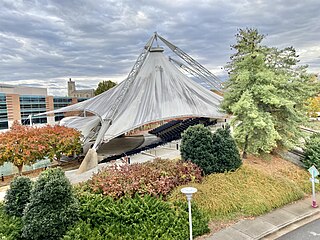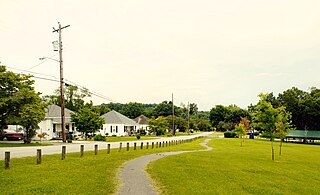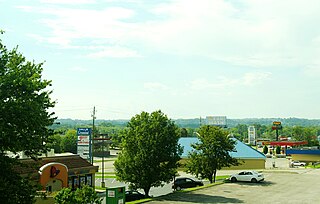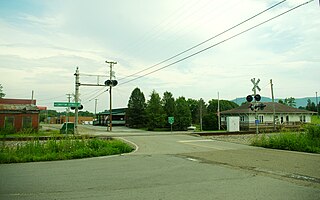
Knox County is located in the U.S. state of Tennessee. As of the 2020 census, the population was 478,971, making it the third-most populous county in Tennessee. Its county seat is Knoxville, which is the third-most populous city in Tennessee. Knox County is included in the Knoxville metropolitan area. The county is located at the geographical center of the Great Valley of East Tennessee. Near the heart of the county is the origin of the Tennessee River, at the confluence of the Holston and French Broad rivers.

Grainger County is a county located in the U.S. state of Tennessee. As of the 2020 census, the population was 23,527. Its county seat is Rutledge. Grainger County is a part of both the Knoxville Metropolitan Statistical Area and Morristown Metropolitan Statistical Area.

Rutledge is a city in and the county seat of Grainger County, Tennessee. The city is part of both the Knoxville metropolitan area and the Morristown metropolitan area. As of the 2020 census, the city had a total population of 1,321.

Knoxville is a city in and the county seat of Knox County, Tennessee, United States. As of the 2020 United States census, Knoxville's population was 190,740, making it the largest city in the East Tennessee Grand Division and the state's third-most-populous city after Nashville and Memphis. It is the principal city of the Knoxville metropolitan area, which had a population of 879,773 in 2020.

Mascot is a census-designated place (CDP) in Knox County, Tennessee. The population was 2,760 at the 2020 census up from 2,411 at the 2010 census.

Maynardville is a city in and the county seat of Union County, Tennessee, United States. The city was named to honor Horace Maynard, who successfully defended the creation of Union County from a challenge from Knox County. Its population was 2,413 at the 2010 census, up from 1,782 at the 2000 census. It is included in the Knoxville metropolitan statistical area.

Plainview is a city in Union County, Tennessee, United States. The population was 2,125 at the 2010 census, up from 1,866 at the 2000 census. It is included in the Knoxville, Tennessee Metropolitan Statistical Area. Plainview is located in the southern part of the county, south of Maynardville, the county seat.

Morristown is a city in and the county seat of Hamblen County, Tennessee, United States. Morristown also extends into Jefferson County on the western and southern ends. The city lies within the Ridge and Valley of the Appalachians. The city's population was recorded to be 30,431 at the 2020 United States census. It is the principal city of the Morristown Metropolitan Statistical Area, which encompasses all of Grainger, Hamblen, and Jefferson counties. The Morristown metropolitan area is also part of the Knoxville-Morristown-Sevierville Combined Statistical Area.

Halls Crossroads is a census-designated place in northern Knox County, Tennessee. As a northern suburb of nearby Knoxville, Halls is included in the Knoxville Metropolitan Statistical Area. The town takes its name from the Thomas Hall family that settled in the area in the late 18th century.

Bean Station is a town in Grainger and Hawkins of Tennessee, United States. As of the 2020 census, the population was 2,967. It is part of the Kingsport, Knoxville, and Morristown metropolitan statistical areas.

Corryton, also known as Corryton Village, is an unincorporated bedroom community in northeastern Knox County, Tennessee, United States, about 15 miles northeast of Knoxville. The United States Geographic Names System classifies Corryton as a populated place. It is included in Knoxville Metropolitan Statistical Area.

Powell, formerly known as Powell Station, is a census-designated place in Knox County, Tennessee. The area is located in the Emory Road corridor, just north of Knoxville, southeast of Clinton, and east of Oak Ridge. It had a population of 13,802 during the 2020 census. It is included in the Knoxville, TN Metropolitan Statistical Area.

U.S. Route 11W (US 11W) is the western branch of US 11 from the twin cities of Bristol, Tennessee/Bristol, Virginia, where US 11 splits into US 11E and US 11W, to Knoxville, Tennessee, where the two highways rejoin. The highway serves the Appalachia region's Ridge-and-Valley section of East Tennessee, bounded by the Clinch Mountain ridge to the north and the Holston River to the south. US 11W from Bristol to Bean Station and Blaine to Knoxville are designated as part of the National Highway System.

State Route 331 is a mostly west–east, signed north–south, secondary highway in Knox County in the U.S. state of Tennessee.

State Route 131 is a south-to-north highway in the U.S. state of Tennessee that is 68.8 miles long. It is designated as a secondary route.

Strawberry Plains is an unincorporated community and census-designated place (CDP) in Jefferson, Knox, and Sevier counties in the State of Tennessee, United States. Before 2010, it was treated by the United States Census Bureau as a census county division. It is included in both the Knoxville Metropolitan Statistical Area and the Morristown Metropolitan Statistical Area.

The Knoxville metropolitan area, commonly known as Greater Knoxville, is a metropolitan statistical area (MSA) centered on Knoxville, Tennessee, the third largest city in Tennessee and the largest city in East Tennessee. It is the third largest metropolitan area in Tennessee. In 2020, the Knoxville metro area had a population of 879,773, and a population of 903,300 including Grainger County. The Knoxville–Morristown–Sevierville Combined Statistical Area (CSA) had a population of 1,156,861 according to the census bureau in 2020.

The Morristown Metropolitan Statistical Area, commonly known as the Lakeway Area, as defined by the United States Census Bureau, is an area consisting of three counties - Grainger, Hamblen, and Jefferson - in eastern Tennessee, anchored by the city of Morristown. Grainger County is both in the Knoxville and Morristown Metropolitans. Including Grainger County, the 2020 census showed that the MSA had a population of 142,709.

Joppa is an unincorporated community in rural central-western Grainger County, Tennessee, United States. It rests below Joppa Mountain, a subrange located near the southern terminus of the 150 mile (240 km) long Clinch Mountain ridge complex, offering views of five U.S. States and the Great Smoky Mountains. Joppa is part of the Morristown, Tennessee Metropolitan Statistical Area, and also a component of the Knoxville-Morristown-Sevierville Combined Statistical Area.

The 1972 Bean Station bus-truck collision was a head-on collision involving a double-decker Greyhound bus and a tractor-trailer on U.S. Route 11W in Grainger County, Tennessee, that occurred near the town of Bean Station on the morning of May 13, 1972.

























